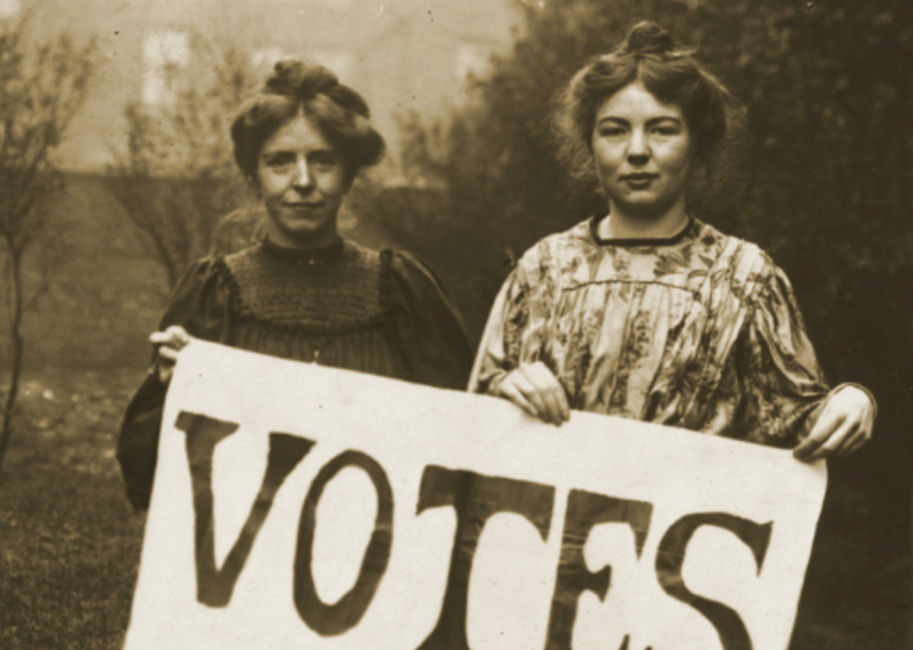WSPU // Wikimedia Commons While it might feel as though it’s been an inalienable right for as long as we can remember, it really wasn’t that long ago that women not only didn’t have the right to vote, but also couldn’t own land, travel freely, or work outside the traditional roles prescribed by society. The 19th Amendment to the U.S. Constitution, which granted American women the right to vote, was passed by Congress on June 4, 1919, and ratified on Aug. 18, 1920. It was also incomplete, benefiting white women almost exclusively due to Jim Crow laws and barriers to citizenship for many women of color in the U.S. at the time. While the United States was one of the earlier countries to grant the vote, they were by no means the first, with countries such as New Zealand and Australia leading the way in equal rights for women. Other countries fell far behind the rest of the world in granting women equal voting rights, and many are still fighting gender bias and discrimination when it comes to equality for women. Regardless, women everywhere continue to make strides, make history, and make changes. And while there is still much to be done before all women can experience gender equality, there is no doubt that the women’s rights movement is alive and well today, and progress will march on for those rights. Using news reports and historical websites, Stacker compiled a list of 50 countries, and when they gave the majority of women the right to vote. The countries are listed in chronological order. This comprehensive list not only showcases the dates women gained suffrage but also how they did it and what their political standing looks like around the world today. Check out the timeline and see when women around the world earned the right to vote. You may also like: Defining historical moments from the year you were born 1893: New Zealand National Library of New Zealand // Wikimedia Commons Led by suffrage activist Kate Sheppard, the women of New Zealand campaigned in the late 1800s, putting together multiple petitions that called for parliament to grant women the right to vote. While the women received a great deal of opposition, with many cabinet members concerned that women would vote for the prohibition of alcohol, their lobbying finally paid off and on Sept. 19, 1893, the bill was signed into law. 1902: Australia State Library of Queensland // Wikimedia Commons In Australia, the women’s suffrage movement was initially divided between two regions, South Australia and Western Australia. In the south, after a struggle for equal rights that lasted for decades, the South Australian parliament passed the Adult Suffrage act in 1894, which not only granted women the right to vote, but also to stand for parliament. In 1899, Western Australia followed suit, and in 1902, the Australian parliament passed the Commonwealth Franchise Act, granting voting rights to all Australian women. Unfortunately, that did not include Indigenous Australian women, who were not given the right to vote until 1962. 1906: Finland Public Domain // Wikimedia Commons Women in Finland were granted the right to vote in 1906, making it the first European country to do so. After political unrest led to a general strike against the czarist regime in 1905, a decree was issued for the creation of a parliament based on universal suffrage in Finland. In 1907, 19 women were elected as members of parliament in Finland’s first parliamentary election, and women continue to play strong political roles in the country today. 1913: Norway Oslo Museum // Wikimedia Commons Even though Norway has long been known for being a leader in equality, Norwegian women actually fought for nearly 30 years for the right to vote. Norway’s parliament first debated the issue in 1890, when it was said that voting could cause women to lose their identities, that it would lead to their degradation, and that it would disrupt homes and families. By 1910, however, women had won the same voting rights as men in local elections, and by 1913, the Norwegian Constitution was amended to include all Norwegian citizens in the right to vote. 1915: Denmark Royal Danish Library // Wikimedia Commons In the 1800s, Denmark’s political activity was only allowed for men over the age of 30 who were the head of their households, which accounted for just 15% of Denmark’s population. Activist Matilde Bajer formed a women’s suffrage group in 1871 and became the leader of the political wing of the Women’s Progress Association, which fought for women’s rights until finally winning the right to vote in 1915. 1915: Iceland Magnús Ólafsson // Wikimedia Commons Iceland’s first political women’s group, The Icelandic Women’s Association, was formed in 1894. Although women had been allowed to vote in local elections since 1881, it took years of lobbying and petitions for them to win the right to vote in national elections. They were granted those rights in 1915, but the law only applied to women over the age of 40. It wasn’t until 1920 that the age restriction was removed. Today, Iceland leads the world in gender equality, ranking #1 by the Global Gender Gap Report for more than a decade. 1917: Canada William James // Wikimedia Commons The fight for women’s suffrage in Canada spanned across the provinces, and women fought for decades for the right to vote. In 1917, those rights were awarded to the majority of Canadian women, with the exception of Indigenous Canadians, both male and female, who did not win the right to vote until 1960. 1917: Russia LSE Library // Wikimedia Commons Suffragette groups in Britain spent years campaigning, marching, rallying, and protesting before women won the right to vote. One of the largest demonstrations took place in 1908 and was organized by the Women’s Social and Political Union with 250,000 attendees. Suffragettes at the rally showed their frustration with the system by smashing windows and tying themselves to nearby railings. Women over 30 were given the right to vote in 1918, but universal suffrage wasn’t granted until 1928 when the law was changed to allow anyone 21 and older to vote. 1919: Netherlands Nationaal Archief // Wikimedia Commons In the Netherlands, the women’s suffrage movement gained ground in the late 1800s, when the feminist movements taking place in England and the United States inspired women in the Netherlands to also take up the cause. Women were granted what was called a passive right to vote in 1917, which meant they could run for office and get elected in politics, but couldn’t vote themselves. It wasn’t until 1919 that women won the right to actually vote in the elections. 1920: United States Bettmann // Getty Images Until 1922, women in Japan not only couldn’t vote, they were not allowed to attend political activities or even voice their opinions on the subject. While women were allowed more autonomy in the political process over time, they weren’t granted full suffrage until 1945. More than 13 million women voted in 1946, the first general election after World War II. Since then, women have become more prominent in politics, although they still represent less than a quarter of the government’s seats. 1947: Argentina Keystone-France/Gamma-Keystone via Getty Images Argentina’s congress granted women the right to vote in 1947. This right was signed into law by President Juan Domingo Peron, whose wife Eva Peron had been a big part of the campaign for women’s suffrage. Eva went on to establish the Peronist Women’s Party, which she headed until her death in 1952. Women were not able to exercise their newfound rights until the general election in 1951 when 3.5 million women turned out to vote. 1947: Pakistan SSPL // Getty Images Pakistan granted women the right to vote in 1947, which was reaffirmed in 1956 to include a provision for a certain number of reserved seats in parliament. In 1988, Benazir Bhutto was elected as prime minister, the first Muslim woman to hold this post, and in recent years, more Pakistani women have been registering to vote. 1947: India Bettmann // Getty Images The movement for women to vote started when India was a British colony, and some women were able to vote following reforms passed in the 1920s. But universal suffrage only really came into play after India gained independence in 1947, and when the Indian constitution was enacted in 1950. While women have continued to become more politically active, they are still underrepresented in India’s parliament, with men occupying the majority of political seats. 1952: Greece Richard Harrington/Three Lions/Getty Images Women in Greece campaigned for universal suffrage as early as the late 1800s, but Greece didn’t grant full voting rights until 1952. Previously, women who were educated and over the age of 30 could vote in local elections, but could not participate on a national level. In 2020, Greece elected Katerina Sakellaropoulou as president, making her the first woman to fill that role. 1953: Mexico Earl Leaf/Michael Ochs Archives // Getty Images Women in Mexico were able to start participating in municipal elections as of 1947, but the right to vote in national elections didn’t come until six years later. A reform was actually passed in 1937 that granted full political rights to women, but it was never officially enacted, and it wasn’t until President Adolfo Ruíz Cortines was elected in 1952 that women gained universal suffrage. 1954: Colombia Bettmann // Getty Images Colombian dictator Gustavo Rojas Pinilla granted women the right to vote in 1954, despite opposition from the Catholic Church. Women were able to exercise that right in elections in 1957, and Colombia has since gone on to elect women for various government offices, although they are still underrepresented as a whole. 1955: Honduras Earl Leaf/Michael Ochs Archives // Getty Images Honduras was the last Latin American country to allow women to vote, granting suffrage in 1955. Women had been fighting for equal rights since the 1920s when the Women’s Cultural Society was established and began to campaign for economic and political rights. As of 2021, just over 27% of political seats in Honduras were held by women. 1956: Egypt AFP via Getty Images After years of campaigning by the Egyptian Feminist Union, which was founded by activist Huda Sharawi, Egypt granted women the right to vote in 1956. Sharawi, who worked to reform women’s personal status and education as well as voting rights, is well known for removing her veil in a Cairo train station, an act of protest that prompted other Egyptian women to do the same. 1957: Malaysia Emilio Ronchini/Mondadori via Getty Images Women in Malaysia, along with all other Malaysian citizens, were granted the right to vote in 1957, after the country gained political independence from the British regime. Activists had been fighting for women’s emancipation since the 1920s, with campaigns for higher education and equal rights. Despite continued lobbying for women to have more power in politics, the percentage of women holding seats remains small–though is slowly rising. 1957: Zimbabwe Daily Express/Hulton Archive // Getty Images The campaign for women’s rights in Zimbabwe was originally initiated by white women, and before 1957, only men and European women were allowed to vote. After 1957, Black women were included, but women didn’t gain the right to stand for office until 1978. 1962: Algeria KEYSTONE-FRANCE/Gamma-Rapho via Getty Images Algeria was under the rule of France until 1962, at which time it obtained its independence. With that freedom came independence for women as well, and they were awarded the right to vote. Despite this, women had to continue fighting for equal rights and are still underrepresented politically. 1962: The Bahamas H. Armstrong Roberts/ClassicStock // Getty Images The women’s suffrage movement in the Bahamas took hold in the 1950s when activist Mary “May” Ingraham founded and eventually became president of the movement. The group held public demonstrations and petitioned the secretary of state for the colonies until a bill giving women the right to vote was eventually enacted in 1962. 1963: Iran AFP via Getty Images Women in Iran won the right to vote and run for parliament in 1963, as well as rights to obtain a divorce and to keep custody of their children. By 1978, 22 women had seats in parliament, and more than 300 served on local councils; however, that ended with the 1979 revolution. Women were removed from office, made to observe the Islamic dress code, and could only work in more traditionally female fields. Today, women can hold public office but are still vastly underrepresented 1963: Morocco KEYSTONE-FRANCE/Gamma-Rapho via Getty Images Morocco granted women the right to vote in 1963, but women weren’t appointed to any political seats until 1997. The state has since mandated that 30% of national and regional legislatures be filled by women. As of 2021, 23% of parliamentary seats in Morocco were held by women. 1964: Libya Keystone-France/Gamma-Keystone via Getty Images Women in Libya were given the right to vote in 1964, and a prohibition against gender bias was issued. After the 1969 military coup of the Moammar Gadhafi regime, women were encouraged to become more involved in politics, but few women were elected or appointed to parliamentary seats. As of 2020, just 16% of seats in Libya’s national parliament were held by women. 1967: Ecuador Seidel/United Archives/Universal Images Group via Getty Images Ecuador originally granted women the right to vote in 1929, when President Isidro Ayora allowed literate Ecuadorian women to vote. Voting was required for men, but remained optional for women until 1967 when a new constitution made voting obligatory for both women and men. In 1979, the literacy requirement was removed, and in 1987 a law was passed that also gave women equality in divorce and property rights. 1971: Switzerland Hulton-Deutsch Collection/Corbis via Getty Images The suffrage movement started in Switzerland in the late 1800s, but it wasn’t until 1971 that women were legally allowed to vote, and in some Swiss cantons, women couldn’t vote until 1991. The country has progressed exponentially since that time, and as of 2021, more than 40% of national political seats are held by women. 1972: Bangladesh Patrick Durand/Sygma via Getty Images Bangladesh gave women the right to vote in 1971, after women fought alongside men in the Liberation War, helping the country to gain independence. Over time, women have become more prominent in Bangladesh’s politics, with female prime ministers regularly elected since 1988. Current Prime Minister Sheikh Hasina Wazed has served since 2009. 1974: Jordan Salah Malkawi // Getty Images Jordan’s constitution was written in 1952 and asserts equal rights for all citizens, barring discrimination based on race, language, or religion; however, those rights didn’t translate to women; women were not awarded the right to vote until 1974. While women have the right to vote and to obtain an education, societal norms still restrict them on many levels. As of 2020, only 12% of political seats in the country were held by women. 1976: Portugal Alain MINGAM/Gamma-Rapho via Getty Images While women in Portugal were awarded the right to vote in 1931, that right was restricted to women who had completed secondary or higher education, as opposed to men who only had to know how to read and write. Those restrictions weren’t fully lifted until after the 1974 revolution, and in 1976, full equality and full voting rights were granted to all. 1980: Iraq Jacques Pavlovsky/Sygma via Getty Images Iraq granted women the right to vote in 1980; however, after the Gulf War in 1991 and subsequent leadership changes, many women’s rights have been reversed, leaving women to continue their fight for equality. As of 2021, women occupied 29% of the political seats in Iraq, and women continue to run for office, working to increase their political quotas. 1989: Namibia RODGER BOSCH/AFP via Getty Images After a campaign tied to universal suffrage rights and racial equality, women in Namibia won the right to vote in 1989. In 2021, women held 44% of the political seats in Namibia. Namibia recently implemented training in female representation in politics as part of its goal to obtain full gender equality by 2030. 1990: Western Samoa PATRIK STOLLARZ/AFP via Getty Images Samoa, originally known as Western Samoa, gave women the right to vote under universal suffrage in 1990. Unfortunately, women’s involvement in politics remains low, with just 8% of political seats in Samoa held by women in 2021. Several advocate groups have been formed in recent years to advocate for Samoan women’s rights, including the Ministry of Women Community and Social Development, and the U.N.’s Human Rights Committee on the Elimination of Discrimination Against Women (CEDAW). 1993: Kazakhstan VYACHESLAV OSELEDKO/AFP via Getty Images Kazakhstan awarded women the right to vote in 1993, and since then, women’s political activity has grown steadily. In 2006, women held only 10.4% of the seats in parliament, but by 2021, that percentage had increased to 27%. In 2019, the country had its first female presidential candidate, Dania Espaeva. 1993: Moldova DANIEL MIHAILESCU/AFP via Getty Images Women in Moldova won the right to vote in 1993 under universal suffrage, but there were no gender quotas for political seats until a new law in 2016. As of 2021, 40% of parliament seats belonged to women. While women in Moldova are considered some of the world’s most disenfranchised, gender equality groups continue to fight for progress in the women’s rights movement. 1994: Oman MOHAMMED MAHJOUB/AFP via Getty Images In 1994, Omani women were awarded the right to vote and stand in parliamentary elections. While all women of the Gulf can now participate in elections, only 2% of Oman’s political seats were held by women in 2021, despite ongoing efforts to close the political gender gap. 2005: Kuwait
When women got the right to vote in 50 countries














